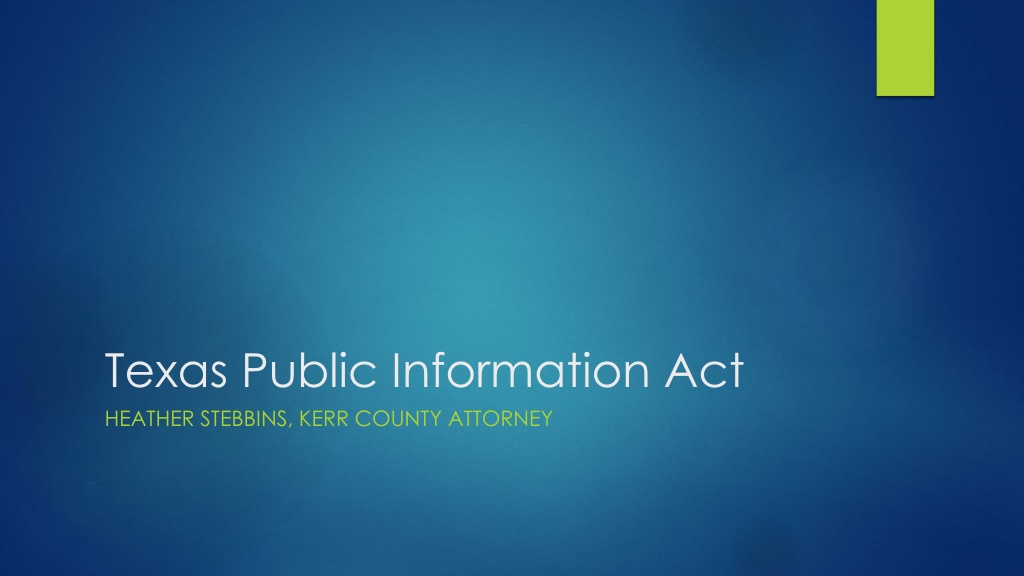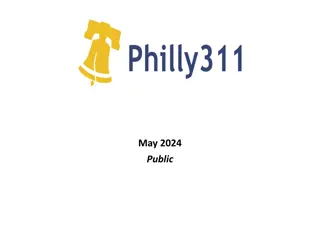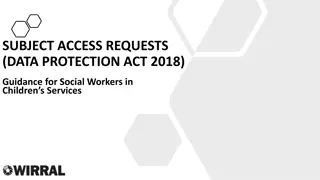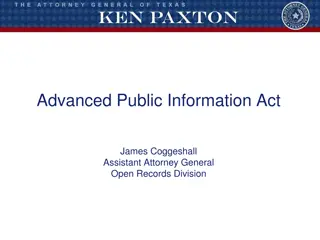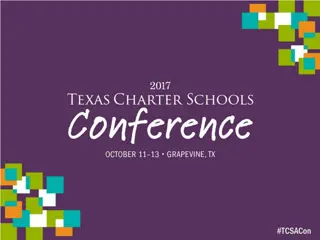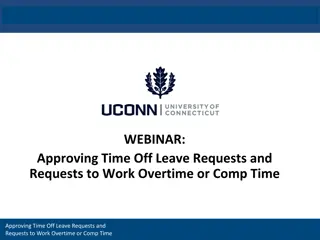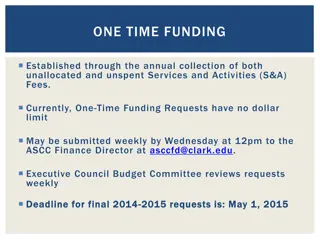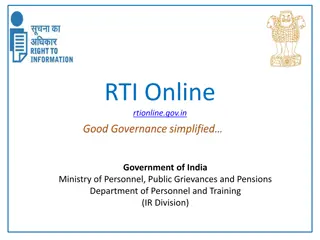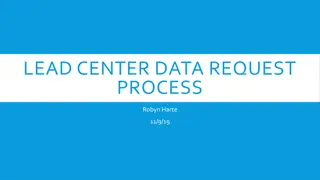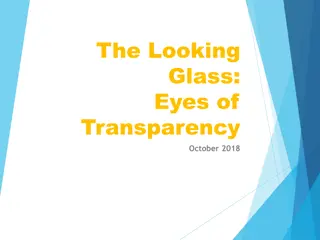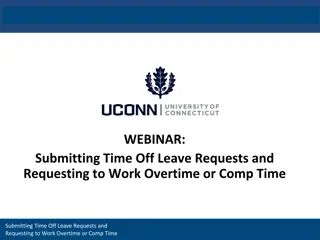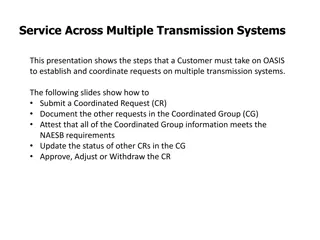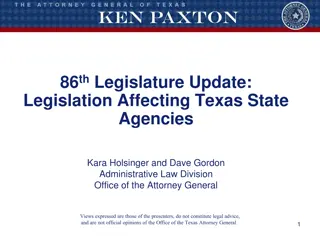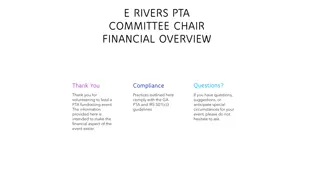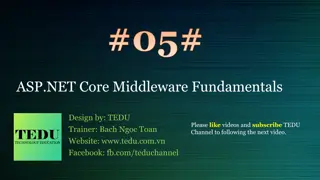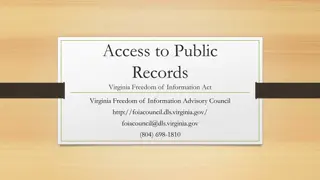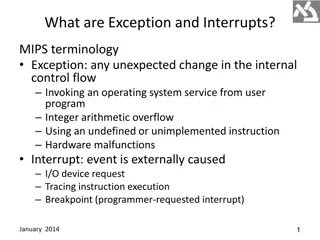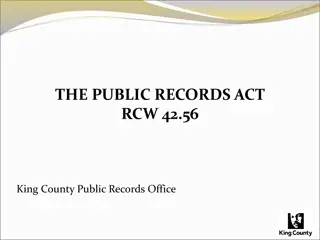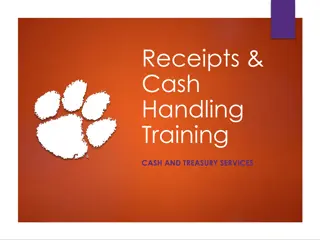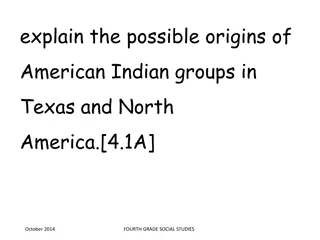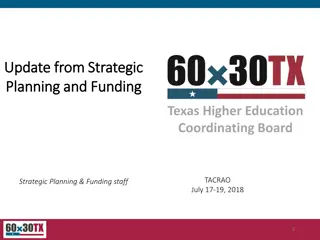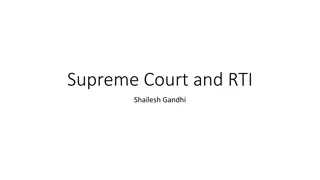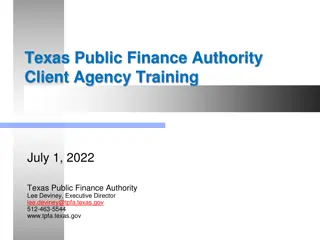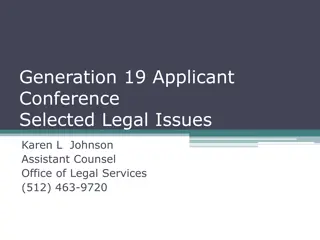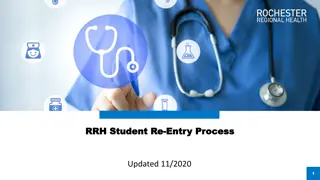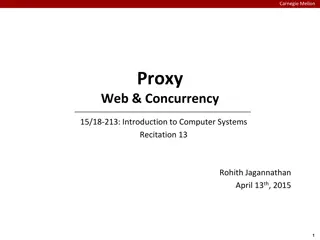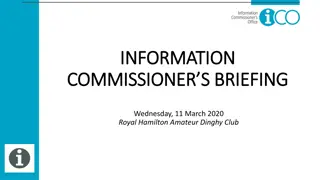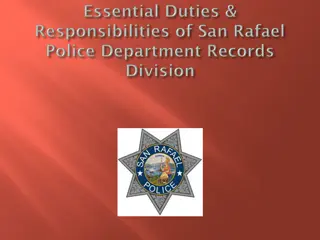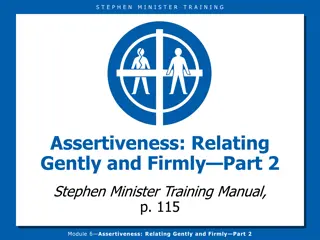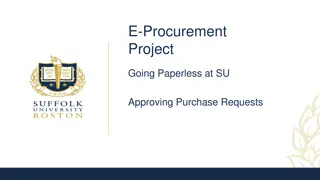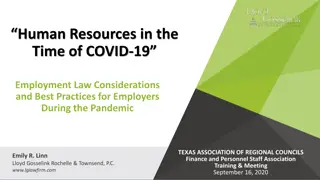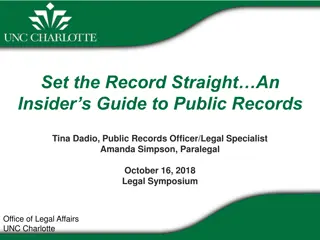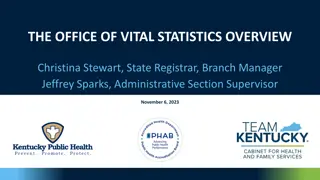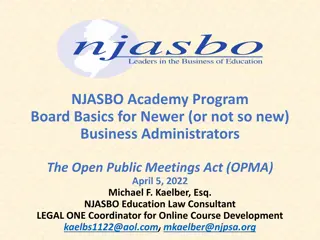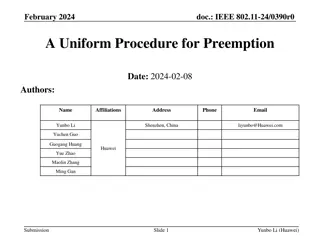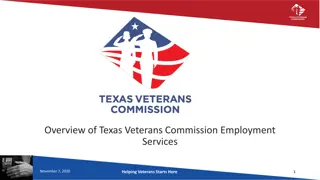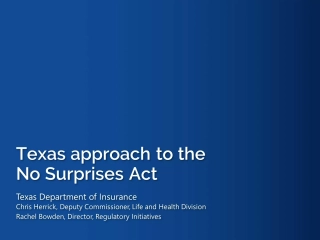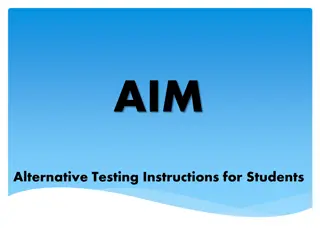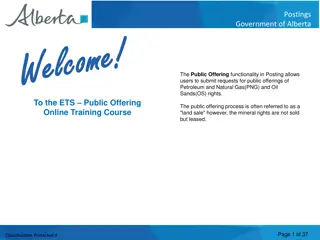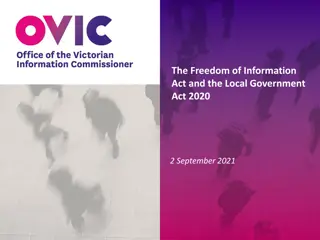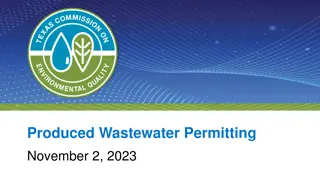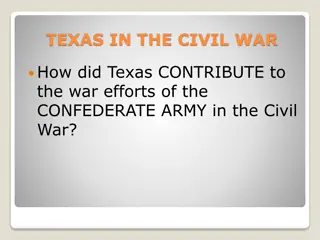Texas Public Information Act Guidelines: Handling Requests Effectively
Learn how to manage public information requests in compliance with the Texas Public Information Act. Discover the steps involved in recognizing, gathering, and releasing responsive records, as well as dealing with cost estimates and seeking rulings from the Attorney General's Office. Ensure a timely and accurate response to information requests effectively.
Download Presentation

Please find below an Image/Link to download the presentation.
The content on the website is provided AS IS for your information and personal use only. It may not be sold, licensed, or shared on other websites without obtaining consent from the author. Download presentation by click this link. If you encounter any issues during the download, it is possible that the publisher has removed the file from their server.
E N D
Presentation Transcript
Texas Public Information Act HEATHER STEBBINS, KERR COUNTY ATTORNEY
How to handle requests 1. Recognize a request that triggers the Public Information Act (the Act ) 2. Identify responsive records 3. Calculate deadlines 4. Determine if a cost estimate is required 5. Gather responsive records 6. Either release the records to the requestor and/or withhold records that do not require a ruling, or seek a ruling from the Office of the Attorney General ( OAG ) 7. While you wait 8. Determine what to do once a ruling is received
Recognize a request that triggers Act A request must be in writing, either typed or handwritten, and A request must ask for information in existence as of the date the request was received.
There is NO REQUIREMENT to: 1.Create new documents; 2.Answer questions; or 3.Perform legal research
Discovery Requests A request for discovery issued in compliance with a statute or rule of civil or criminal procedure is NOT considered to be a request for information under the Act.
Recognize a request that triggers the Act A written request must be delivered to the officer for public information or a person designated by the officer by: US mail Email Hand delivery Any appropriate method approved by a governmental body, including fax and electronic submission through the body s website. A governmental body may designate one mailing address and one electronic mail address for receiving written requests for public information. If these are posted on the website, the body is NOT required to respond to a written request unless it is received at one of those addresses, by hand delivery, or by a method approved by the governmental body.
2. Identify responsive records If there are no responsive records, be sure to let the requestor know as soon as possible. Section 552.222 of the Government Code provides that a governmental body: MAY NOT ask a requestor why they want the information; MAY ask the requestor to narrow the scope of the request; and MAY ask the requestor to clarify what information the requestor is seeking. Note: The 10 business day period to request an AG decision is measured from the date the request is clarified or narrowed. City of Dallas v. Abbott, 304 S.W. 3d 380, 387 (Tex. 2010).
3. Calculate deadlines Start counting the next business day after receiving a valid request. Only county business days (not Saturdays, Sundays, or any other day the governmental body is closed or operating with a skeleton crew holidays, inclement weather days). Remember: Received means when it is physically received, not when it is opened or read. If a governmental body requests clarification or to narrow the request, begin counting the next business day after receiving a response from the requestor. If a request for clarification or narrowing has been sent, the request is withdrawn by operation of law if the governmental body has not received a response by the 61stcalendar day after it was sent. A request received after business hours is considered received the following business day.
4. Determine if a cost estimate is required Section 552.2615 If a governmental body plans on charging the requestor, and the cost for complying with the request will exceed $40, then you MUST give the requestor a cost estimate letter before it complies with the request. A request is considered withdrawn is the requestor does not respond within 10 business days after the date the letter is sent to the requestor. Section 552.263 If the cost for complying with the request will exceed $100 for a governmental body with more than 15 full time employees or $50 for a governmental body with fewer than 16 full time employees, then you MAY require a deposit or bond for payment before complying with the request. A request is considered withdrawn is the requestor fails to make the deposit or post the bond before the 10thbusiness day after the date the deposit or bond is required. Cost letter generator: https://www2.texasattorneygeneral.gov/og/public- information-cost-estimate-model
5. Gather responsive records Set internal deadlines. For a governmental body with multiple departments, the public information coordinator can appoint public information liaisons within each department to help gather any responsive information. IT departments can help you search large amounts of electronic data
Are the records responsive to the request? Is it the right individual? Is it the right date range? Are these the right terms? Is this the right report or incident? Is this the right RFP? Set aside any records that are not responsive because they are irrelevant for purposes of the request. If there is information that the requestor would be willing to voluntarily exclude, confirm that with the requestor so you can make redactions and satisfy their request without having to request a ruling from the OAG.
What next? Pursuant to sections 552.221 and 552.301 of the Government Code, a governmental body must: 1. Promptly produce records for inspection, duplicate or both; 2. Ask for a decision from the OAG about whether the record is excepted from disclosure, unless there is statutory authority for the governmental body allowing the governmental body to withhold records without seeking a ruling, or there is a previous determination that the information is excepted; or 3. Some combination of both.
6. Release and/or withhold the records that do not require a ruling Withhold records without requesting a ruling Section 552.130 Information related to driver s license, motor vehicle title or registration, or personal identification document. Section 552.136 Credit card, debit card, and access device numbers Sections 552.024, 552.1175, 552.138 Personal information of certain public employees A governmental body must use the form letters on the OAG s website to inform requestors of redactions made under these sections without a ruling. https://www.texasattorneygeneral.gov/open- government/governmentalbodies/responding-pia-request/redacting-public-information
Previous Determinations Open Records Decision No. 684 (2009) allows governmental bodies to withhold several types of information typically found in personnel files without requesting a ruling. Examples: peace officers address, phone numbers, social security numbers, information revealing whether employee has family members; Examples: direct deposit authorization, Form I-9, W-2 and W-4 forms, certified agenda of a closed meeting, fingerprints, L-2 and L-3 declarations, Texas driver s license, license plate numbers, photos or videos that show license plate numbers, credit and debit card numbers, bank account numbers, insurance policy numbers, routing numbers, email address of a member of the public, DD-214 or other military discharge record.
6. Seek a ruling from the OAG 552.301 and 552.305 No later than the 10thbusiness day, a governmental body MUST: Ask the OAG for a ruling and state the exceptions that apply; Notify the requestor in writing that you have asked for a ruling; Provide the requestor a copy of your letter to the OAG requesting a ruling; and Notify any third parties with proprietary interests in the requested information that they may submit written comments to the OAG why the records should be withheld (required to use the OAG form https://www.texasattorneygeneral.gov/open- government/governmental-bodies/proprietary-information-request)
Seek a ruling from the OAG 552.301(e) and (e-1) Not later than the 15thbusiness day, a governmental body MUST: Submit written comments stating the reasons why the stated exceptions apply. Submit a copy of the written request for information. Submit a signed statement as to the date on which the request for information was received or evidence sufficient to establish that date. Submit a copy of the specific information requested, or submit representative samples of the information if it s voluminous. Label the copy of the records to indicate which exceptions apply to which parts of the copy. Send a copy of your letter to the OAG to the requestor.
Seek a ruling from the OAG Things to think about when submitting the letters to the OAG and the requestor: Provide sufficient evidence to establish the date the governmental body received the request. If there is any ambiguity, address it in your letter to the OAG. Provide sufficient evidence to establish when the governmental body mailed the letters to the OAG and the requestor. Send copies, NOT originals. Do NOT apply redactions to documents you submit to the OAG. You can highlight or otherwise identify information you are seeking to withhold, but don t black it out. Make sure to mark exhibits clearly. Make sure to identify what s been released to the requestor. Reference all previous correspondence with the Open Records Division ( ORD ) in any future correspondence. If you ve previously received a ruling on the same or very similar information, let the ORD know.
Seek a ruling from the OAG Continued Provide adequate background information on the documents submitted: How are these records responsive? How are they related to the pending investigation? Who are the parties mentioned in the documents? What is their relationship to the governmental body? What, if anything has already been released? Do you have a pending cost estimate complaint?
7. While you wait Acknowledgement fax is a receipt of ruling request indicating information the governmental body still needs to submit to comply with 552.301(e). Section 552.303(c)-(e) letter means OAG needs more information to issue a ruling, and failure to timely respond may result in the legal presumption that the records being request are required to be disclosed and must be released. Section 552.306 letter means the OAG needs more time to handle the request. The OAG can only extend the deadline once.
8. Determine what to do once a ruling is received Follow the ruling Call the Open Government Hotline (877)673-6839 Challenge the ruling in court
